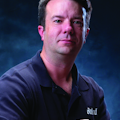Thermal Imaging: What To Do When The Police Call for Help
I am sure it has happened to your fire department. Two o’clock in the morning and the police want you to set up the aerial so they can get overhead photos of a crime scene or they need to borrow a ladder so they can check the roof of a building near a robbery to see if the suspect threw his gun up there. They call you after the tow trucks have hauled the cars away because they need to borrow some of the “kitty litter” you carry on the truck. They call you because they arrived on a “check-the-welfare” call and the foul odor they noticed from the front porch is a hint that entry will need to be forcible. I know they call you out because they want to borrow your thermal imager.
I have worked with many police departments to integrate thermal imaging into their operations. Although there are several companies that make thermal imagers specialized for police and/or military roles, the most common response I receive from police is, “If we need one, we will just borrow an imager from the fire department.” So, since it seems likely that you will be called out to assist the police with a thermal imager at some point, I thought it would be helpful to look at the eight most common activities for which police use thermal imagers.
• Fugitive searches. The ability to locate, at a distance, fleeing or hiding suspects is clearly helpful for apprehension. Dark or camouflaged clothing can make bad guys extremely difficult to discern from their surroundings. With a thermal imager, you can locate a suspect regardless of camouflage or dark clothing and you can cover large areas at a single glance, unlike a flashlight that has a limited cone of visibility within the beam of light.
• Scene safety. With a thermal imager, a quick “scene survey” can be conducted from some distance away. You could easily identify anyone outside the residence, as well as dogs or other animals present on the property. You find an unconscious individual lying in the middle of the park. Is the assailant still in the area or did he flee when he heard the sirens? Find out. A quick thermal scan of the area can tell you whether you are alone or you need to prepare to defend yourself.
• Surveillance activities. The more savvy criminals (if there are such people) have caught on to standard surveillance techniques. They know that most surveillance is done with binoculars, video cameras or night-vision devices. These criminals have taken to using high-powered lights to conceal their business. None of the above-mentioned surveillance techniques is effective against this practice. Thermal imaging, on the other hand, does not react to light. A thermal imager cannot “see” light. You can now look past the headlights and see clearly what is going on. You can even record it for evidence at trial.
• Hidden compartments. Let’s start off here by making one thing perfectly clear, and I think you already know this. A thermal imager will not see through anything. It is not X-ray vision. It sees only heat being radiated from surfaces. It is easy to become misled. Look at any interior wall (made of drywall) and you can plainly see the studs that support that drywall. However, what you are actually seeing is the thermal interaction of the stud with the drywall; not the stud itself.
It is common for contraband to be hidden during transport or shipping. Using a thermal imager, you can spot thermal irregularities and interactions that don’t appear normal. While this may not be a dead giveaway that there is or is not a hidden compartment, it can definitely focus your attention to the area that is abnormal. Split fuel tanks, hollow body panels that are stuffed full, loaded tires and even automotive body fillers and putties are easily identifiable under a thermal inspection.
• Accident investigation. Traffic accident re-constructionists often begin measurements from the start of the first visible skid mark in an effort to determine speed at impact. Modern cars equipped with anti-lock braking systems are designed to not leave such marks; however, rapidly slowing a vehicle, even with no visible skid, requires huge amounts of friction between tires and pavement. This friction leaves thermal signatures that can linger for longer than you might think. Although many variables come into play in determining how long these marks would be visible, a fair estimate may be 30 to 45 minutes post-crash.
Ever found a vehicle wrapped around a tree or off in a field, but found no one inside? Ever used a thermal imager to search the surrounding area for victims who might have stumbled from the wreck only to collapse from their injuries several minutes and several hundred feet later? Or, better yet, as one police department found, ever found an intoxicated driver who climbed the tree that he wrapped his vehicle around in an effort to avoid apprehension? In searching the surrounding field for victims and finding none, officers returning to their cruisers spotted a large white object in the tree immediately above the wreckage. There they found the driver, too intoxicated to flee, who had climbed the tree to hide from responding police.
• Search and rescue. How many times have you been sent to look for a small child who ran away from home? How about a senior citizen who is afflicted with Alzheimer’s? In both circumstances, we are rarely called to the scene as soon as it happens. Usually, the family will search until dark and then call 911 when their efforts fail. With a thermal imager, you can cover large areas in short order. Depending on the manufacturer, you can see up to three-tenths of a mile in any direction. That’s a search circle over a half-mile in diameter.
Large fields, parks, roadways and wooded areas are all easily searched with a thermal imager. Creeks and streams also offer a unique use for thermal imaging. Ever worked in the rain around swollen creeks or streams looking for someone thought to have fallen in? Ever responded to a pond, lake or ocean on an overturned canoe or boat? One characteristic of water is that it usually looks very cool to a thermal imager. Victims, on the other hand, appear very warm. This makes for a bright white object on an otherwise dark gray/black field of view. Stop using the flashlight as your primary search tool. It can safely be moved to secondary. Put the thermal imager up front. Use it to search these bodies of water.
• Disturbed surfaces. The theory behind disturbed surfaces is that once an otherwise uniform surface has been rendered non-uniform, it can never be made to appear uniform again. I know what you’re thinking…huh? Let me explain it this way: criminals may take a metal shipping crate that the large cargo haulers use and torch a hole in the side of it, build a false wall, stuff it full of contraband, weld the cover back on, sand the weld and repaint the surface so that it appears as if nothing has been altered. To the eye, all appears normal. To a thermal imager, the weld, sanding and repainting can be seen because of the difference in the way that metal wall absorbs and radiates heat. This difference is visible to the thermal imager. Altered drywall? Visible. Overturned earth or recently buried areas? Visible. Body fillers and putties as used in the hidden vehicle compartments? All visible to thermal imaging.
• Locating evidence. Concealed weapons tossed during a foot pursuit, firearms thrown from moving vehicles, drugs discarded and even recently handled empty beer cans in a vehicle will all generally yield a latent thermal image. Some objects, like recently fired weapons, display a much stronger thermal image than others; however, having the ability to detect and recover all evidence not only aids in the investigation, but ultimately better serves the public.
While we have covered the most popular uses for thermal imaging in law enforcement, please understand that there are many other uses out there and some still to be discovered. Even though they may wait until 2 o’clock in the morning to call for our assistance, we don’t want anything bad to happen to our brothers and sisters in blue, and we all want to help them with public safety.
BRAD HARVEY is the Thermal Imaging Product Manager at Bullard. He is a veteran of public safety as a firefighter, police officer and paramedic and is certified through the Law Enforcement Thermographers’ Association (LETA) as a thermal imaging instructor. Harvey has worked as a high-angle rescue instructor and is a certified rescue technician and fire instructor. If you have questions about thermal imaging, you may email him at [email protected].
WHY THE POLICE CALL US FOR HELP
? Fugitive searches
? Scene safety
? Surveillance activities
? Hidden compartments
? Accident investigation
? Search and rescue
? Disturbed surfaces
? Locating evidence
About the Author
Brad Harvey
BRAD HARVEY is the Thermal Imaging Product Manager at Bullard. He is a veteran of public safety as a firefighter, police officer and paramedic and is certified through the Law Enforcement Thermographers’ Association (LETA) as a thermal imaging instructor. Harvey has worked as a high-angle rescue instructor and is a certified rescue technician and fire instructor. If you have questions about thermal imaging, you may e-mail him at [email protected].

